Chapter 36 (Part 1) — Adventures in the Austrian Alps
Introduction
We had a bright idea in the early spring of 1980 after we had sold our little fermette in l’Indre. Also, we had already enjoyed a bit of mountaineering in the Colorado Rocky Mountains during our almost unbelievable tour of the United States in 1979. We would probably enjoy going hiking in the Austrian Alps. So we thought and we were right.
In our first year in Austria we tried both Vorarlberg and, after that, Tyrol, probably mainly
because our long-time friend Jürgen Austrian/Parisian, came from Lermoos in Tyrol, where his family have a big hotel and restaurant, Sporthotel Loisach.
We did not stay at that fancy hotel, but at a Gästehaus in Ehrwald, right next-door, but we did have dinner there a couple of times though. We got to know the old Saint Bernard dog who usually slept on the floor in the restaurant lobby. Even Jürgen can not remember her name any more.
So after Brand we drove to Tyrol and Lermoos-Ehrwald, where we spent a short week under the imposing Zugspitze (2,962 m), which towers over the valley.
We found that there was a far greater choice of walks in Brandnertal, for different levels of stamina and experience. We walked to a couple of Almen (which is what Alpen are called in this region). Eine Alpe (Alme) is a place up in the mountains where the sheep and cattle are taken during the summer months. The area is beautiful, but our only memorable walk in the Lermoos area was to Coburger Hütte, where we had a spectacular view over the valley and surrounding mountains — even though, as we well remember, it was really chilly up there, and there was a whipping wind.
After Tyrol, we even went to Mittelberg, Austria, to meet with our friend Ruth’s parents in their summerhouse. A beautiful red house, and we liked Ruth’s parents a lot. We were to see them later in Paris too, and we actually had them over for dinner at rue Caillaux.
Various other travels after the 20 summer vacations in Brand
Repeated trips to India came after the turn of the century. In between, however, there were two spectacular summer vacations in Lapland, northernmost Sweden, and then three wonderful tours of the Scottish Highlands, center, west and east, to the ‘Mainland’, which is the main island of the Orkneys
The Mainland offered spectacular archeological sites, and we also saw some out west, on trips to the scenic Inner (Skye, Mull) and Outer Hebrides (Harris and Lewis).
Ireland had already been the site of a fascinating visit in 1997– what I was known to call a historic and prehistoric tour. I return to Ireland, or mostly Dublin, in Chapter 37.
Newgrange in Ireland is of course very much prehistoric, dating from circa 3,200 BC. as well as several other prehistoric sites we visited..
I will get back to most of these travels in later chapters. A photo safari in Tanzania will get two chapters by itself.
Brandnertal
Now back to 1980 and our first visit to Brandnertal and Haus Kella-Egg, which John had found out about at the Austrian tourist bureau in Paris. The town looked delightful on the map he brought home and there seemed to be a great variety of walks. Plus, it was at the end of the road — no through traffic with trucks and speeding cars. And no nightclubs We decided to try it. That was the beginning of twenty summers at Haus Kella-Egg.
A large number of walks began at the Lünersee at an altitude of 2000 m. You reached it by a Seilbahn (funicular or aerial cableway), or, — after we got more daring — by climbing up on Böser Tritt, (evil walk) a fun but not easy 400 m. climb up. The problem was the beginning and the end that were a bit boring. When you reached the end of the rock climbing, which we liked a lot, there was quite a bit of tedious climbing on the grassy hill side to get up to the lake and to Douglashütte..
There were of course lots of ther walks, Amatschonjoch, Sarotlahütte, and many others, where you started out from the valley or with the Niggenkopfbahn, a chairlift on the western side of the valley.
ngg_shortcode_0_placeholder” order_by=”sortorder” order_direction=”ASC” returns=”included” maximum_entity_count=”500″]I will relive here a few of the most striking hikes we made during these twenty years when we regularly spent close to three weeks in the summers at Haus Kella-Egg, hosts Gerti and Sepp Königer, who became dear friends and not just hosts. Their son Günter (English teacher in Bludenz) and his beautiful wife Lisi have now taken over running the house, and I do hope that Gerti does not make beds any more. There are three grandchildren, Manfred, Jessica and I forget the name of the third one, a boy. And young and beautiful Lisi has become a grandmother — Jessica has a little girl. It seems almost unbelievable.
We also made friends with Fritz und Renate Lange the very first year. As we emerged from Saulajochsteig and the walk down to Heinrich-Hueterhütte, we ran into Fritz and Renate who were also staying at Haus Kella-Egg. They were eating Kaiserschmarren, an Austrian egg-and-flour-and-raisin specialty, which our good friend Ruth, German-Parisian, had also recommended. It was delicious and we were to eat Kaiserschmarren many times during those twenty summers in various Hütten in the area.
Zimba is a huge rock that you don’t climb without an experienced guide and with a rope around your body. Our Sepp was such a guide and somewhere in the middle of our twenty summers in Brand, he took wife Gerti up on Zimba. I am sure Geri loved it. A movie was taken (by Sepp?) which we were shown one evening in the breakfast-room. Geri looked very happy and completely fearless.
Our very dauntless friends Fritz and Renate actually once crossed the Zimbajoch, on the western side of the big rock, a Joch that separates the Heinrich-Hueter valley from Sarotlahütte. They must have started out on Saulajochsteig, walked along the Joch and then turned left towards Zimba to cross over Zimbajoch, 2359 m. From Sarotlahütte on the other side of the Joch it was of course downhill, but that can be hard on the knees too, as we knew well. That was quite a feat for our friends. Hats off. (Chapeau!) John and I mostly admired Zimba and the Zimbajoch sitting at the outside table with something good to eat and drink at the Sarotlahütte, which I found quite enough for my over-the-years declining stamina. It is at 1611m, which starting at 900m. makes it a fair climb in itself.
Back to reality now. The walk that I remember best from the first year, 1980, was to Totalphütte, from where we later took many different walks further up after the altitude of circa 2000 m. at Lünersee and Douglashütte. What amazed us this first year was the amount of snow there was up at Lünersee and above in the middle of the summer. We never saw that much snow in any later year, even though in 1981 when there was again a lot of snow above 1500 m. altitude. In 1980 kids were sledding down the slopes next to the hut on big pieces of cardboard. Anything goes. Totalphütte would undergo lots of changes and extensions, both inside and on the terrace during our 20 years in Brand.
In spite of the masses of snow, however, we saw some of the most exquisite flowers we would ever see in the Austrian Alps. And that is saying a lot. John very soon became a fellow flower lover. That, for a man who until then had only known the names of tulips and roses, was a noteworthy change.
In German the name of this anemone (right) is Gletscher-Hahnenfuß; isranunkel in Swedish (ranunculus glacialis). In English it is Glacier buttercup, a direct translation from German.
We saw the same sweet little anemones on our first walk to Saarbrückenerhütte from the Montafon valley east of Brandnertal, in 1981. The few times I have come across those very special and rare flowers, my heart fills with joy. We saw those a couple of times in Lapland too when I was just 14 years old.
We had wanted to try out the neighboring Montafon valley as well, but we did not at all like it as well as Brandnertal. We were snowed in at a Gästehaus in Gargellen in 1981, and I called up Frau Königer (who very soon became Gerti to us) and asked if we could come one day earlier than we had reserved for. We could. I remember there was snow up to our knees in the Gargellen forest.
Lindauerhütte
In 1981 we went on a long trek to the Lindauerhütte, setting out by walking to the southern end on Lünersee and taking the path towards the impressive mountain at Schweizertor.
Lünersee, at an altitude of approximately 2000 m. is the center of a huge number of walks, in all directions, and in our twenty summers in Brand, we have probably taken them all.
We had planned on spending the night there and coming back the next day. Sepp Königer told us that there would be no problem getting sleeping places, if we referred to him, saying we were Königer guests. Wrong. We arrived in the afternoon on this glorious sunny day after a very interesting but fairly tiring walk. The mountains bordering on Switzerland were on our right, and we walked up and down on several mini-mountains before arriving at the Hütte. We had a good meal on the terrace in the sun, BUT there was just one Matratzenlager left. If we could spend the night, the two of us on the floor on one mattress, it was all right. We decided we could not. The host (Hüttenwirt) said we could ‘just‘ walk to the village 8 km away, to the railroad that would take us to Bludenz, and from there we would get to Brand. It would be just a short walk he said, and no problem. Right.
ngg_shortcode_1_placeholder” order_by=”sortorder” order_direction=”ASC” returns=”included” maximum_entity_count=”500″]We walked and walked and walked, through a forest and through fields on some kind of path, then along a sand roadway by a stream. Our feet got sorer and sorer. We had not yet learned to put a pair of thin socks inside the woolen ones. However, we made it, a bit the worse for wear, to the railroad. The next train would mean waiting for quite some time and we were tired. And hungry too I am sure. We took a taxi all the way to Haus Kella-Egg in Brandnertal from Montafontal, or its beginning. We had had it with hardship. I don’t remember if we got anything to eat that evening, but I am sure Gerti fixed up something for us, as we arrived pretty exhausted and pretty late. And with sore feet!
Sarotlahütte
This steeply ascending valley has a dramatic history since it was partly destroyed in a violent storm in the early 90s.
The 700 m climb up through the freest mostly is quite steep for the most part. However, when you get to about halfway up this field opens up with the fabulous Eisenhut. Then you go on, and on, and on. The first time, which was our very first year in 1980, I thought we would never get to the Hütte. Towards the end you go through another kind of forest, Lärchen this time, and it is beautiful. Larches of course, which are the only conifers that lose their leaves in the winter. (Larches: Deciduous Conifers in an Evergreen World)
On the way up climbing over rocks and tree roots you get to a place where you cross the stream running down the valley and you see all three waterfalls under the dark green pine trees.
On the way down (or up, I don’t remember) in 1987 we met the old-looking man who might not have been old at all, just bent over. He and his tired-looking horse made this trip up and down every day, for decades, I believer, to deliver food and drink to the Hütte.
Saulajoch – Saulakopf – Saulajochsteig
The ‘path’ (if that is a proper word for the rocky things you balance on here) that we very likely took the most often of all the high mountain paths, was Saulajochsteig (Steig = path) from a distance looking like a somewhat lighter colored line on the side of the steep mountain. The very first time we took the Seilbahn up to Douglashütte and Lünersee, I saw with great fear the line on the mountain to the east and said famously “There I will never walk. That’s for Gemsen (mountain goats) only.”
ngg_shortcode_2_placeholder” order_by=”sortorder” order_direction=”ASC” returns=”included” maximum_entity_count=”500″]From Douglashütte at the top of the Seilbahn we many many times walked east towards Lünerkrinne and from there on to the gorgeous and much beloved Saulajoch. On the way we took the shortcut via ‘Königersteig‘, so named by the Langes (Fritz und Renate) who claimed that our Sepp Königer had found the path and inaugurated it. However that may be, it was not a path for small children and alpine beginners. In the middle of the path, for quite a long stretch, the mountain comes right down to the ‘path’ and more or less does away with it. I always put my hand on the side of the mountain to feel more secure and where there was no path you just had to try and find a rock that would hold a foot. (The path to Südschafgafall (Gafall = slope) where we also went several times, was pretty much the same on a short stretch.) We got very used to ‘Königersteig‘ though’, and it did not seem hairy any more after the first time or so.
Views from Südschafgafall — the sheep welcome you on your way up.
ngg_shortcode_3_placeholder” order_by=”sortorder” order_direction=”ASC” returns=”included” maximum_entity_count=”500″]But now, back to Königersteig, after which came the glorious opening up of a vast valley, called Saulajoch since it actually is a Joch (a pass from one region to another). The absolutely fabulous flowers that we saw in this fairy-tale valley is not easy to describe. There were masses of Alpenrosen (wild azalea, red and pink) and endless carpets of Silberwurz (Sw. fjällsippa, mountain avens – Dryas octopetala)).
Also, not to be forgotten, we would always see the somewhat rare Feld Kleinenzian, purple gentian, and the delicate Troddelblume (Soldanella alpina, a primulaceae flower), which might just be my favorite ever of all the gorgeous flowers we got to know and love in the Alps. About gentians, the small blue ones are the most common, but gentians exist in all imaginable colors and and shapes, yellow, deep red and a great number of various blue ones, big and small. So to those are added the adorable pale purple ones, which was always saw in quite great numbers at the south end of of Saulajoch.
The masses of wonderful flowers added immensely to our love of the Alps. There was more to it than just the gorgeous scenery and the fun walking and climbing. The incredibly wonderful flora in the forests, alpine meadows and on the stony areas high up where there was no grass — Totalp being the best example of this — played a big part in our desire to come back year after year. John got to be as great a lover as I was of blooming meadows, all the various gentians higher up — the deep purple Akelei and big bluebells in the lower forests. Akelei is columbine in English, and we had seen some in the Colorado Rocky Mountains in ’79.
After the incredibly wonderful Saulajoch came came the Saulajochsteig back to Lünersee. I have said enough about ordinary walking conditions. So here comes the BIG story.
On John’s birthday August 8, 1984, we took the Saulajochsteig both ways, since it was the shortest way of getting to Saulakopf, the first mountain we climbed during these twenty years. We were not yet hardened mountain climbers, and I was as tense as can be when I held on to one boulders and climbed forward-upward with great care. Wherever there were cables, I of course felt a lot safer. There is a sign in the valley pointing to the path to Saulakopf telling hikers and climbers “Nur für Geübte. Trittsicherheit erdorderlich, Bergschuhe und Schwindelfreiheit.” No problem, said John and Siv.
ngg_shortcode_4_placeholder” order_by=”sortorder” order_direction=”ASC” returns=”included” maximum_entity_count=”500″]Saulakopf is the mountain at the northern end of Saulajoch, which serves as background to a lot of pictures from Saulajoch. The way up to the peak of Saulakopf, after a pleasant zigzag climb over a grassy hillside, then got to be nothing but huge boulders. No path at all. John was much more fearless than I was. He wrote in our Tagebuch though, that “there were cables in some places and other places where there should have been. I must have missed my footing once since I actually scratched up the inside of my right hand some, and John — ever the perfect gentleman — tied his handkerchief around it.
We made it to the top, however, and it was the most gemütlich group of people we have ever met on a mountain peak. John had run out of film, and one fellow gave him a roll. Also some fearless youngsters were sitting on the edge of the mountain top, their legs dangling over the void. I was NOT broken in yet as a mountain climber and after this day I had the sorest leg muscles I have ever had in my life, mainly due to my tenseness while climbing through the huge boulders, both up and down. I could hardly walk up and down the stairs in Haus Kella-Egg for a couple of days..
As we got down, we saw heavy clouds gathering in the west and we got out our rain tents that we had bought in Norway in ’82. We always carried those in our packs. We were ready for heavy rain. Little did we know what we were in for.
We met a family in the valley by the sign where the path takes off to Saulakopf. The man had a polaroid camera and after we took a picture of him and his family, he took this picture of us (below) in our Helly Hansen rain tents. We were all in a good mood, thinking that we were now in for a good rain and a bit of an adventure. Well, it got to be a bit more dramatic than we had counted on.
It was raining now, a normal shower, as we were getting close to the Saulajochsteig.
Then came the cloudburst. And it was not just an ordinary cloudburst, it was a deluge. We got wet from our knees down into our boots and at least up to our elbows from clutching the cables, getting our hands right into the frequent mini-waterfalls over the cables. And yes, there was heavy thunder and lightning too. It was not very different from walking under a waterfall. (Yes, I have been under a waterfall, in 1950 when sister Gun and I took a shower under a waterfall in Lapland in 1950 — to cool off on our two-week trek around Sarek.)
Saulajochsteig, which we had already on the way out found somewhat hairier than we remembered, had now been transformed into a narrow stream. A man we met saw a stone falling and warned us that there would be more. There was — a minor rock slide, caused by the unusually heavy storm. John was out of the falling stones, but I had to hide under a rock (says our Tagebuch), a detail I had completely forgotten. Rock slides are not to be taken lightly, but this was not a big one. What I do remember vividly was all the waterfalls that had formed wherever there was a small opening in the mountain wall on our left. We put our hands right into the waterfalls, I with my bandaged hand and all. There was no other way to get through this storm and get safely to Douglashütte. It is odd how, in a situation like this, you don’t even think of being afraid. All you think of is getting ahead.
After we got to the end of the ‘Steig‘, there was this boring and very tiring walk up on an ordinary path across the steep and grassy slope up to Doulashütte.
We reached Douglashütte, with totally soaked lower arms and legs. The hut was filled with other “drowned rats” (says John in our trip-book) who, like us, were seeking refuge from the storm. They had clearly hurried to shelter from any of the multitude of walks that start at the Lünersee. From here there was now only the Seilbahn left and the drive down the valley to Haus Kella-Egg, which is a few hundred meters lower than the beginning of the funicular.
Rarely have we been so pleased to sit down in a warm place, even if Douglashütte had never been one of our favorite huts. I suppose though that, after this harrowing experience, we celebrated coming to third base with some Jägertee or, more likely, a glass of Obstler. Jägertee is actually a thing we only learned about the following year in the Mannheimerhütte where we were snowed in and playing Casino with an incomplete deck of cards. Obstler is what Austrians most often drink as Schnapps — after the meal, not before, which is a habit John and I find bizarre.
When we finally got back to Haus Kella-Egg, we found that the Königers had worried about us. They knew of course where we were and that there was a ferocious storm going. Weather not recommended for mountain climbing. They were relieved to see us, soaking wet but in good cheer.
_________________
Our last summer in Brandnertal (Brand valley) got to be the year 2000 when we said farewell to a number of our favorite hikes. Until then we had spent every summer vacation in Brand except in 1990, the year we went to Argentina.
In the year 2000 we rediscovered the wonders of what was probably our most unforgettable hike, to Gemslücke (Gemsluggen, or alternative spellings in old Swiss German) on the very border between Austria and Switzerland.
Also in the year 2000 we were the subjects of an Ehrung at Haus Kella-Egg, after we had spent twenty summers in Brand. There was a speech by a man from the tourist agency, and we got a trophy, a medal and a fine picture book about Brandnertal.
Continued: Chapter 36 (Part 2) — Some very special Alpine flowers
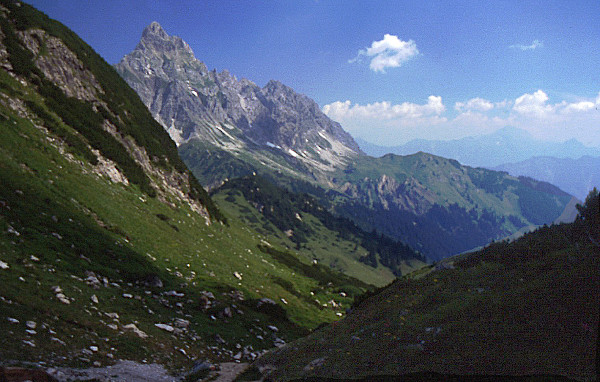
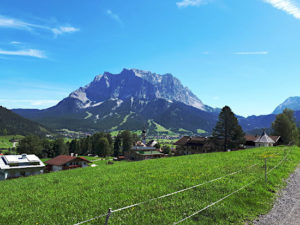
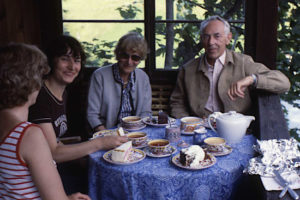
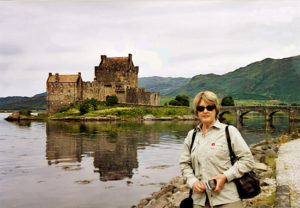
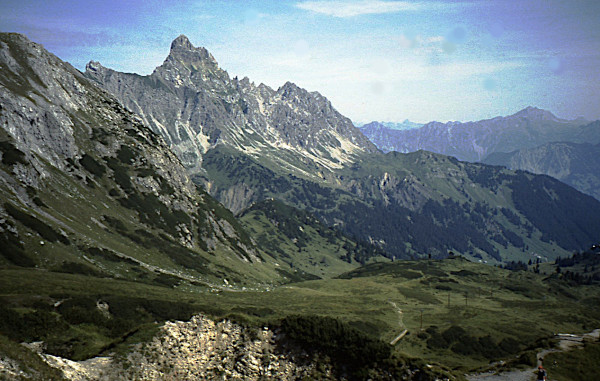

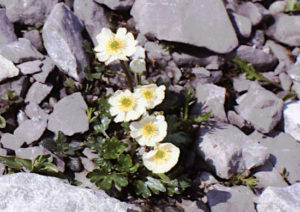
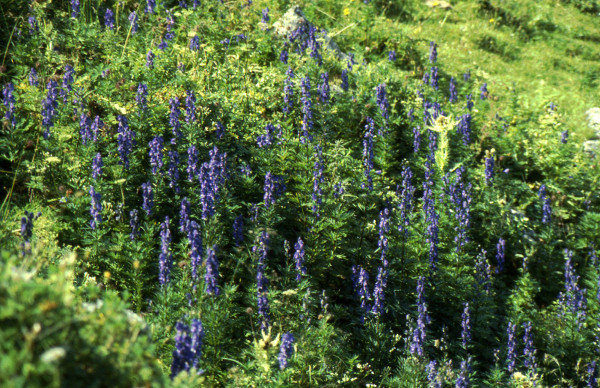
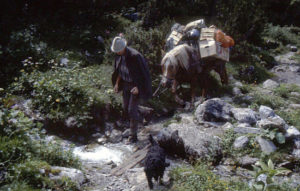
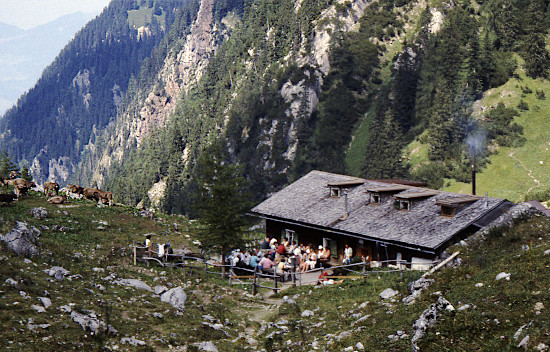
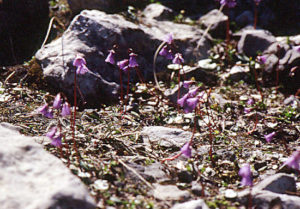
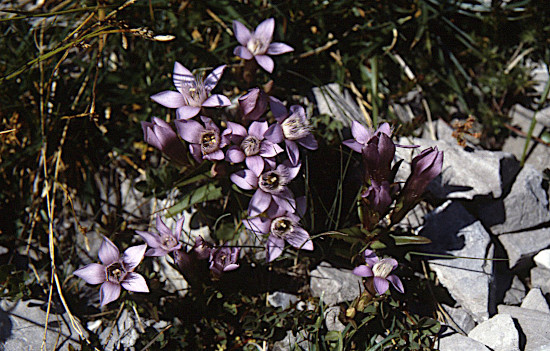


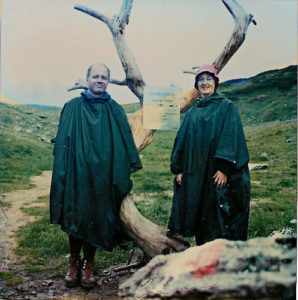
I didn’t know we had this picture with all the three waterfalls, but John helped me out.